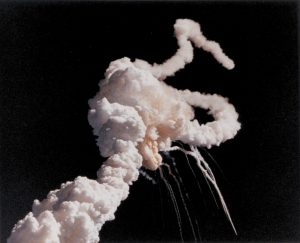Chapter 3 Engineering Disasters
Aeronautical Disaster – Space Shuttle Challenger 1986
For more background on this disaster, you can access the following links:
https://en.wikipedia.org/wiki/Space_Shuttle_Challenger_disaster

On January 28, 1986, the Space Shuttle Challenger and her seven-member crew were lost when a ruptured O-ring in the right Solid Rocket Booster caused an explosion soon after launch. This photograph, taken a few seconds after the accident, shows the Space Shuttle Main Engines and Solid Rocket Booster exhaust plumes entwined around a ball of gas from the External Tank. Because shuttle launches had become almost routine after twenty-four successful missions, those watching the shuttle launch in person and on television found the sight of the explosion especially shocking and difficult to believe until NASA confirmed the accident.
Space Shuttle orbiter Challenger (OV-099) (mission STS-51-L) broke apart 73 seconds into its flight, leading to the deaths of its seven crew members.

